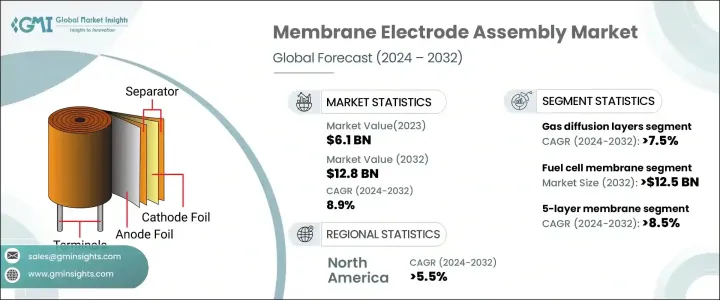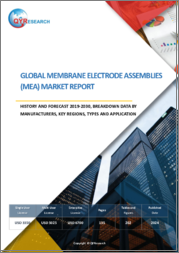
|
시장보고서
상품코드
1684783
막 전극 접합체 시장 기회, 성장 촉진요인, 산업 동향 분석, 예측(2024-2032년)Membrane Electrode Assembly Market Opportunity, Growth Drivers, Industry Trend Analysis, and Forecast 2024 - 2032 |
||||||
세계의 막 전극 접합체 시장은 2023년에 61억 달러의 평가 금액에 이르렀으며, 2024년부터 2032년까지 연평균 복합 성장률(CAGR)은 8.9%를 나타낼 것으로 예상됩니다.
연료전지 및 기타 전기화학 장치에 필수적인 구성요소인 막 전극 접합체는 전기를 생성하는 화학 반응을 가능하게 하는데 매우 중요한 역할을 합니다. 이 전극 접합체는 양성자 전도성 필름, 애노드 촉매 및 캐소드 촉매로 구성되며, 모두 에너지 변환 효율을 극대화하기 위해 협력합니다. 청정 에너지 솔루션, 특히 수소를 기반으로 한 기술에 대한 주목 증가는이 시장의 큰 성장을 가속하고 있습니다.

세계 정부와 민간 부문이 신재생에너지에 대한 대처에 많은 투자를 하고 있으며, 연료전지 채용을 더욱 뒷받침하고 있습니다. 또한 연료전지의 효율, 내구성 및 비용 효율성 향상이 막 전극 조립 설계의 혁신을 촉진합니다. 산업계는 비용을 절감하면서 성능을 향상시키기 위해 재료 조성과 제조 공정 최적화를 선호합니다. 자동차, 거치형 발전, 휴대용 전자기기에서 연료전지의 적용 확대는 고품질의 막 전극 접합체에 대한 수요를 더욱 가속화하고 있습니다. 세계의 에너지 상황이 지속가능성으로 옮겨가는 가운데, 막 전극 접합체 시장은 이러한 전환을 뒷받침하는 중요한 역할을 담당하고 있습니다.
| 시장 범위 | |
|---|---|
| 시작 연도 | 2023년 |
| 예측 연도 | 2024-2032년 |
| 시작 금액 | 61억 달러 |
| 예측 금액 | 128억 달러 |
| CAGR | 8.9% |
가스 확산층 분야는 2032년까지 연평균 복합 성장률(CAGR) 7.5%를 나타낼 것으로 예측됩니다. 지속적인 R&D 노력으로 재료 특성이 개선되고 효율과 수명이 모두 향상되었습니다. 기공의 크기와 분포를 조정함으로써 반응물질의 질량 운송과 수분 관리가 최적화되어 연료전지 전체의 성능을 향상시킬 수 있습니다. 또한 제조기술의 혁신으로 비용을 절감하고 보다 폭넓은 용도로 이용하기 쉬워지고 있습니다. 업계가 고성능·장수명 연료전지 개발에 주력하는 가운데 가스 확산층의 진보가 시장 성장에 크게 영향을 줄 것으로 예상됩니다.
5층 막 전극 접합체 부문은 2032년까지 연평균 복합 성장률(CAGR) 8.5%를 나타낼 것으로 예상됩니다. 연료전지의 내구성과 신뢰성이 강조되어 이러한 접합체의 채택이 가속화되고 있습니다. 특정 응용 분야에 최적화된 재단사의 시스템 설계가 시장 확대에 기여하는 반면, 지속적인 기술 발전으로 연료전지 스택이 개선되었습니다. 바이폴라 플레이트 및 가스 확산층과 같은 주요 구성 요소의 기술 혁신은 업계 동향을 강화하여 연료전지 성능의 일관된 발전을 보장합니다. 이러한 개발로 제조업체는 효율적이고 신뢰할 수 있는 연료전지 솔루션에 대한 수요 증가에 대응할 수 있게 되었습니다.
북미의 막 전극 접합체 시장은 2032년까지 연평균 복합 성장률(CAGR) 5.5%를 나타낼 것으로 예측됩니다. 연료전지 기술의 채용을 촉진하는 데 있어서 정부의 지원 정책과 재정적 인센티브가 중요한 역할을 하고 있습니다. 수소 인프라를 확대하고 연료전지 자동차 구매를 촉진하는 것을 목표로 한 전략적 이니셔티브는 시장 성장의 원동력이 되었습니다. 자동차 제조업체, 연구기관, 정부기관의 연계가 기술의 진보를 촉진해, 업계의 채용을 가속하고 있습니다. 이러한 파트너십은 생산 규모 확대, 효율성 향상 및 비용 절감에 필수적이며 앞으로 수년간 시장의 꾸준한 성장을 보장합니다.
목차
제1장 조사 방법과 조사 범위
- 시장의 정의
- 기본 추정과 계산
- 예측 계산
- 데이터 소스
- 1차
- 2차
- 유료 소스
- 무료 소스
제2장 주요 요약
제3장 업계 인사이트
- 업계 생태계 분석
- 벤더 매트릭스
- 규제 상황
- 업계에 미치는 영향요인
- 성장 촉진요인
- 업계의 잠재적 리스크 및 과제
- 업계 전망에 대한 COVID-19의 영향
- 성장 가능성 분석
- Porter's Five Forces 분석
- PESTEL 분석
제4장 경쟁 구도
- 전략 대시보드
- 혁신과 지속가능성의 전망
제5장 시장 규모와 예측 : 구성 요소별(2019-2032년)
- 주요 동향
- 멤브레인
- 가스 확산층
- 개스킷
- 기타
제6장 시장 규모와 예측 : 용도별(2019-2032년)
- 주요 동향
- 연료 전지
- 전해조
제7장 시장 규모와 예측 : 제품 유형별(2019-2032년)
- 주요 동향
- 3-layer
- 5-layer
- 7-layer
제8장 시장 규모와 예측 : 지역별(2019-2032년)
- 주요 동향
- 북미
- 미국
- 캐나다
- 유럽
- 독일
- 영국
- 프랑스
- 이탈리아
- 오스트리아
- 스페인
- 아시아태평양
- 중국
- 호주
- 인도
- 일본
- 한국
- 중동 및 아프리카
- 사우디아라비아
- 아랍에미리트(UAE)
- 남아프리카
- 라틴아메리카
- 브라질
- 페루
- 멕시코
제9장 기업 프로파일
- Ballard Power Systems
- WL Gore &Associates, Inc.
- Danish Power Systems
- BASF SE
- Giner Inc.
- IRD Fuel cells
- Greenerity GmbH
- Plug Power Inc.
- HyPlat Pty Ltd.
- Cummins Inc.
- FuelCell Energy, Inc.
- TOSHIBA CORPORATION
- Pansonic Holdings Corporation
- Dupont
- Johnson Matthey
- 3M
- EC21 Inc.
- Yangtze Energy Technologies, Inc
- YuanBo Engineering Co., Ltd.
- Ion Power, Inc.
The Global Membrane Electrode Assembly Market reached a valuation of USD 6.1 billion in 2023 and is expected to grow at a CAGR of 8.9% from 2024 to 2032. Membrane electrode assemblies, essential components in fuel cells and other electrochemical devices, play a pivotal role in enabling chemical reactions that generate electricity. These assemblies consist of a proton-conducting membrane, an anode catalyst, and a cathode catalyst, all working together to maximize energy conversion efficiency. The increasing focus on clean energy solutions, particularly in hydrogen-based technologies, is driving significant growth in this market.

Governments and private sectors worldwide are investing heavily in renewable energy initiatives, further boosting the adoption of fuel cells. Additionally, advancements in fuel cell efficiency, durability, and cost-effectiveness are fostering innovation in membrane electrode assembly designs. Industries are prioritizing the optimization of material compositions and manufacturing processes to enhance performance while reducing costs. The growing application of fuel cells in automotive, stationary power generation, and portable electronics is further accelerating the demand for high-quality membrane electrode assemblies. As the global energy landscape shifts toward sustainability, the membrane electrode assembly market is poised to play a critical role in supporting this transition.
| Market Scope | |
|---|---|
| Start Year | 2023 |
| Forecast Year | 2024-2032 |
| Start Value | $6.1 Billion |
| Forecast Value | $12.8 Billion |
| CAGR | 8.9% |
The gas diffusion layers segment is projected to grow at a CAGR of 7.5% through 2032. Continuous research and development efforts are driving improvements in material properties, enhancing both efficiency and longevity. Adjustments in pore size and distribution are optimizing reactant mass transport and water management, leading to better overall fuel cell performance. Innovations in production techniques are also reducing costs, making these assemblies more accessible for a broader range of applications. As the industry focuses on developing high-performance, long-lasting fuel cells, advancements in gas diffusion layers are expected to significantly influence market growth.
The 5-layer membrane electrode assembly segment is anticipated to expand at a CAGR of 8.5% through 2032. The rising emphasis on fuel cell durability and reliability is accelerating the adoption of these assemblies. Tailored system designs optimized for specific applications are contributing to market expansion, while ongoing technological advancements are refining fuel cell stacks. Innovations in key components, such as bipolar plates and gas diffusion layers, are strengthening industry trends and ensuring consistent progress in fuel cell performance. These developments are enabling manufacturers to meet the growing demand for efficient and reliable fuel cell solutions.
North America membrane electrode assembly market is forecasted to grow at a CAGR of 5.5% through 2032. Supportive government policies and financial incentives are playing a crucial role in promoting the adoption of fuel cell technologies. Strategic initiatives aimed at expanding hydrogen infrastructure and encouraging the purchase of fuel cell vehicles are driving market growth. Collaborations among automakers, research institutions, and government agencies are fostering technological advancements and accelerating industry adoption. These partnerships are essential for scaling production, improving efficiency, and reducing costs, ensuring steady market growth in the coming years.
Table of Contents
Chapter 1 Methodology & Scope
- 1.1 Market definitions
- 1.2 Base estimates & calculations
- 1.3 Forecast calculation
- 1.4 Data sources
- 1.4.1 Primary
- 1.4.2 Secondary
- 1.4.2.1 Paid sources
- 1.4.2.2 Unpaid sources
Chapter 2 Executive Summary
- 2.1 Industry 3600 synopsis, 2019 – 2032
Chapter 3 Industry Insights
- 3.1 Industry ecosystem analysis
- 3.1.1 Vendor matrix
- 3.2 Regulatory landscape
- 3.3 Industry impact forces
- 3.3.1 Growth drivers
- 3.3.2 Industry pitfalls & challenges
- 3.4 COVID- 19 impact on the industry outlook
- 3.5 Growth potential analysis
- 3.6 Porter's analysis
- 3.6.1 Bargaining power of suppliers
- 3.6.2 Bargaining power of buyers
- 3.6.3 Threat of new entrants
- 3.6.4 Threat of substitutes
- 3.7 PESTEL analysis
Chapter 4 Competitive landscape, 2023
- 4.1 Strategic dashboard
- 4.2 Innovation & sustainability landscape
Chapter 5 Market Size and Forecast, By Component, 2019 – 2032 (USD Million)
- 5.1 Key trends
- 5.2 Membranes
- 5.3 Gas diffusion layers
- 5.4 Gaskets
- 5.5 Others
Chapter 6 Market Size and Forecast, By Application, 2019 – 2032 (USD Million)
- 6.1 Key trends
- 6.2 Fuel cells
- 6.3 Electrolyzer
Chapter 7 Market Size and Forecast, By Product Type, 2019 – 2032 (USD Million)
- 7.1 Key trends
- 7.2 3-layer
- 7.3 5-layer
- 7.4 7-layer
Chapter 8 Market Size and Forecast, By Region, 2019 – 2032 (USD Million)
- 8.1 Key trends
- 8.2 North America
- 8.2.1 U.S.
- 8.2.2 Canada
- 8.3 Europe
- 8.3.1 Germany
- 8.3.2 UK
- 8.3.3 France
- 8.3.4 Italy
- 8.3.5 Austria
- 8.3.6 Spain
- 8.4 Asia Pacific
- 8.4.1 China
- 8.4.2 Australia
- 8.4.3 India
- 8.4.4 Japan
- 8.4.5 South Korea
- 8.5 Middle East & Africa
- 8.5.1 Saudi Arabia
- 8.5.2 UAE
- 8.5.3 South Africa
- 8.6 Latin America
- 8.6.1 Brazil
- 8.6.2 Peru
- 8.6.3 Mexico
Chapter 9 Company Profiles
- 9.1 Ballard Power Systems
- 9.2 W. L. Gore & Associates, Inc.
- 9.3 Danish Power Systems
- 9.4 BASF SE
- 9.5 Giner Inc.
- 9.6 IRD Fuel cells
- 9.7 Greenerity GmbH
- 9.8 Plug Power Inc.
- 9.9 HyPlat Pty Ltd.
- 9.10 Cummins Inc.
- 9.11 FuelCell Energy, Inc.
- 9.12 TOSHIBA CORPORATION
- 9.13 Pansonic Holdings Corporation
- 9.14 Dupont
- 9.15 Johnson Matthey
- 9.16 3M
- 9.17 EC21 Inc.
- 9.18 Yangtze Energy Technologies, Inc
- 9.19 YuanBo Engineering Co., Ltd.
- 9.20 Ion Power, Inc.












